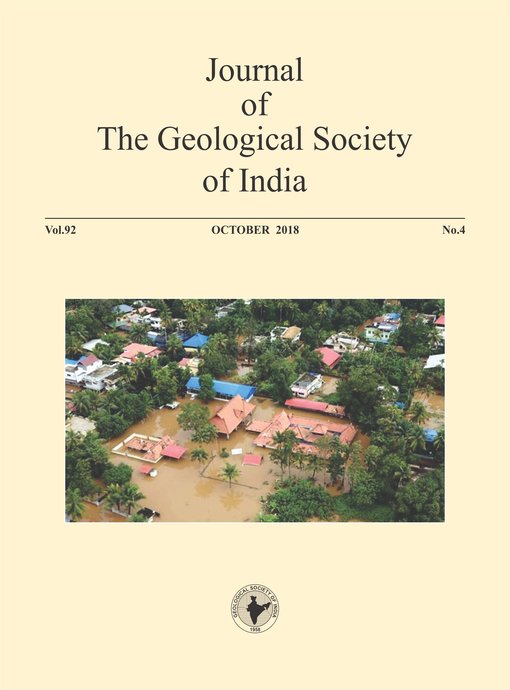Fractures Effect in Reservoir Quality of Ilam and Sarvak Formations in Hengam Oilfield Using Imaging Logs
DOI:
https://doi.org/10.1007/s12594-018-1047-yAbstract
In this study, an attempt has been made through the data of one of exploratory wells as well as using petrophysical and FMI visual logs, the lithology, structures and failures of the field is investigated. For petro physical analysis of the area, after initial field investigation and controlling the drilled units, final approximation of the lithology of the area was made. Afterwards the raw data of well was used for the evaluation of petrophysical parameters by Geolog software. In the next step the effect of fractures on the oil production and their comparison with the initial porosity was analyzed. The results showed that the points with highest production and exploitation of the oil exists, have the greatest expansion of fractures. Comparison of the obtained results with the lithology specifications of other wells of the field shows that in zones with secondary fractures relative to the porosity the reservoir quality has been more appropriate and outputs the highest production and in comparison, the wells No.3, 4 and 5 in spite of having zones of higher porosity than the well number 2 of the lower reservoir quality.Downloads
Metrics
Issue
Section
Downloads
Published
How to Cite
References
Aali, J., Rahimpour-Bonab, H. and Kamali, M. (2006), Geo chemistry and origin of the world's largest gas fields from Persian Gulf, Iran. Jour. Petroleum Sci. Engg., v.50(3–4), pp. 161-175.
Aganabati, A. (2004) Geological of Iran. Published Geological Survey of Iran, 1,606p. [in Persian]
Aghli, G., Fardin, F., Mohamadian, R. and Saedi, G. (2014) Structural and fracture analysis using EMI and FMI image Log in the carbonate Asmari reservoir (Oligo-Miocene), SW Iran, Jour. Geopersia, v.4(2), pp. 169-184.
Al-Husseini, M.I., (2000), Origin of the Arabian Plate structures; Amar collision and Najd Rift. Geo Arabia, v.5(4), pp.527-542.
Alsharhan, A.S. and Nairn, A.E.M. (1997) Sedimentary Basins and Petroleum Geology of the Middle East. Elsevier, Netherlands.
Basheni, M. (2009) Predicting petro physical characteristics of the reservoir using artificial neural networks and well data encryption, master's thesis, Faculty of Engineering, Kerman University of Iran, 153p., [In Persian].
Buryakovsky, L., Chilingar, G.V., Rieke, H.H. and Shin, S. (2012) Fundamentals of the Petro physics of Oil and Gas Reservoirs, Wiley publish, 400p.
Ghassem-Alaskari, M.K. (2012) Advanced well logging, Petroleum University of Technology. Iran, Setayesh Press. 396p. [in Persian]
Ghazban, F. and Motiei, H. (2009) Petroleum geology of the Persian Gulf, Tehran University Publication, 707p.
Hajikazemi, E., Al-Aasm, I.S. and Coniglio, M. (2010) Sub aerial exposure and meteoric diagenesis of the Cenomanian–Turonian Upper Sarvak Formation, southwestern Iran. Jour. Geol. Soc. London, v.330, pp.253– 272.
Hearst, J.R., Nelson, P.H. and Paillet, F.L. (2000) Well Logging for Physical Properties: A Handbook for Geophysicists, Geologists, and Engineers, New York, John Wiley and Sons, 483p.
Honarmand, J. and Madahi, A. (2011) The relationship of sedimentary facieses with expanding diagenesis processes and reservoir quality of Sarvak Formation upper part in one of the great oil field, south west of Iran. Jour. Strat. Res. Sediment., v.27(1), pp.43-54.
James, G.A. and Wynd, J.G., (1965) Stratigraphic nomenclature of Iranian oil consortium, agreement area. AAPG Bull., no.49, pp.2182-2245.
Khanjani, M., Mosavi-Herami, S.R., Rahimpor-Bonab, H., and Kamali, M.R. (2014) Sedimentary environment, diagenesis and stratigraphy of the upper part of Sarvak Formation (Mishrif equivalent) in Siri oil fields, Iranian Jour. Geol. Sci., v.19(4), pp.87-98 [in Persian].
Konyuhov, A.I. and Maleki, B. (2006) The Persian Gulf Basin: Geological history, sedimentary formations, and petroleum potential. Lithology and Mineral Resources Jour., v.41(4), pp.344-361.
Masoudi, P., Tokhmechi, B., Bashari, A. and Jafari, M.A. (2012) Identifying productive zones of the Sarvak formation by integrating outputs of different classification methods. Jour. Geophys. Engg. v.9(3), pp.282–290.
Mehrabi, H., Rahimpour-Bonab, H., Enayati-Bidgoli, A.H., Esrafili-Dizaji, B. (2014) Impact of contrasting paleo climate on carbonate reservoir architecture: Cases from arid Permo-Triassic and Humid cretaceous platforms in the south and southwestern Iran. Jour. Petroleum Sci. Engg., No.126. pp. 342-365.
Nik, I. (2015) Fractures Effect Analysis in reservoir quality of Ilam and Sarvak Formation in Hengam oil Field using Image Log and Petro physical Data, Islamic Azad University, Science and Research branch, MSc. thesis on Petroleum Engineering. Iran, 101p. [in Persian].
Sadegi, M. (2009) Using neural network to estimate porosity and water saturation using well log data and comparison with the methods of neutron logs and density logs, Shahrood University Press, 34p.[in Persian].
Sadooni, F.N. (2014) Petro physical Characterization of the Late Cretaceous Carbonates of Central Iraq: a Quantitative Method for Reservoir Subdivision Conference Proceeding: Reservoir Quality of Clastic and Carbonate Rocks: Analysis, Modeling and Prediction, London, UK; 05/ 2014, pp.154-157.
Schlumberger, (2000) Inc. Log interpretation-Principles/Application, Schlumberger Educational Services, Houston, TX, 198 p.
Sfidari, E., Kadkhodaie-Ilkhchi, A. and Najjari, S. (2012), Comparison of intelligent and statistical clustering approaches to predicting total organic carbon using intelligent systems. Jour. Petroleum Sci. Engg., v. 86, pp.190205.
Tiab D. and Donaldson, E.C. (2012) Petro physics, Third Edition: Theory and Practice of Measuring Reservoir Rock and Fluid Transport Properties, 3rd Edition, Amazon publish 915p.
Vafaei, H., Rahimpoor-bonab, H. andJahani, D. (2014) Identification and seperation of different porous/nonporous using FMI logs in South Pars gas field, south of Iran, Geochem. Jour., v.1(1), pp.3-9.
Zamannejad, A, Muvahed, B. and kohansal, N. (2007) Petro physical evaluation and the comparison of the changes of reservoir properties for Sarvak formation and kazhdomi in a well of Azadegan oil field located on west south of Iran. 3th conference applied Geology and environment, Islamic Azad University, Islamshar branch. Iran, v.1, pp.142-155 [in Persian].
Zare Reisabadi, M. and Ghorashi, S.S. (2017) The Effect of Fault plane on the horizontal in situ stresses orientation: a case study in one of Iranian oilfield. Jour. Petroleum Sci. Tech., v.7(1), pp.35-41.

 Naser Ebadati
Naser Ebadati






